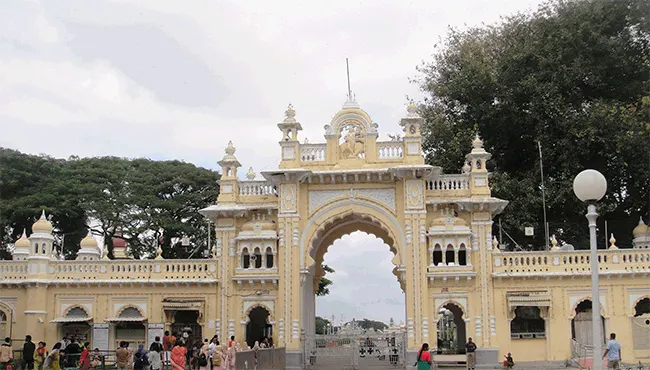
Sri Anjaneya temples of Mysore
Sri Anjaneya Swamy of Sri Chamundeshwari Temple, Chamundi Hills, Mysuru
Sri Anjaneya Temple, Chamundi Hill Step-walkway, Mysuru
Sri Anjaneya Swami Temple, Dewan Purniah Choultry, Mysuru
Sri Sanjeevaanjaneya temple, Brahmapuri Gate, Mysore Palace, Mysore
Mysore
In earlier days after long service in Government or a reputed company a person from a middle-class family will think of spending his post-retirement time peacefully in a healthy place. He will also think of medical facilities and education facilities for children available at that place. For many, the choice was Pune, Indore, Khandwa, Bangalore, and Coimbatore to name some and a few more of the individual choice of the person concerned.
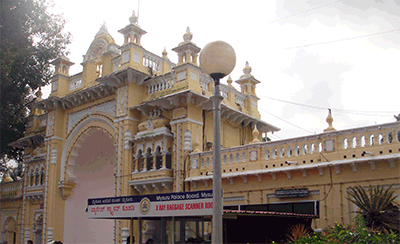 After Bangalore became an industrial city from early independence, Mysore became the next choice and a more popular place for many in the south. Mysore is a city which has a rich culture, thanks to the legacy of the Maharajas of yester years. Even now the city is easy to live. The city is known for the simplicity of the folks living there. By and large a peace-loving city. The city is clean and healthy. The Chamundi hills form the backdrop for the city and thereby the beauty of the city is enhanced. The city provides excellent educational and medical facilities.
After Bangalore became an industrial city from early independence, Mysore became the next choice and a more popular place for many in the south. Mysore is a city which has a rich culture, thanks to the legacy of the Maharajas of yester years. Even now the city is easy to live. The city is known for the simplicity of the folks living there. By and large a peace-loving city. The city is clean and healthy. The Chamundi hills form the backdrop for the city and thereby the beauty of the city is enhanced. The city provides excellent educational and medical facilities.
The city is built around the old-fort – now known as Mysore Palace.
Mysore palace
Any visitor will be wonderstruck by the hugeness of the palace as well as by the design and magnificence of the structure. Well-maintained gardens form part of the areas surrounding the buildings.
The main palace complex is 245 ft in length and also 156 ft in width. The palace has three entrances: the East Gate - the front gate, opens only during the Dasara and that too only for dignitaries, the South Gate and North Gate are open to the public. There are other gates used for specific purposes and they are not open to the public. Visitors can enter either through the North gate or South gate during specified times.
Mysore palace Gates
Although these gates are popularly named after the direction in which they are situated, each of the gates in the palace has a specific name. The North entrance has two arches – each with separate gates - and these gates are known as Jayarama and Balarama gates. The East Gate is known by the name Jayamarthanda Gate. The South gate is known as the Varaha gate. Not just these gates; the other gates also have specific names – obviously for some reason. It is interesting to know why the South gate should be called ‘Varaha Gate’. Is it because there is a temple for Sri Varaha Murthy near the gate? Let us examine.
Varaha Swamy
We all know that Lord Maha Vishnu had taken the avatar in the form of a boar – ‘Varaha’ in Sanskrit. He took this avatar to bring up the earth from the primordial waters, where the demon Hiranyaksha had kept the ‘earth’ stolen by him. Maha Vishnu rescued the mother earth – Maa Booma Devi, by slaying Hiranyaksha and restoring her to her rightful place in the universe.
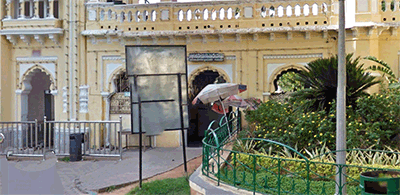 The Agni Purana, Narada Purana, Bhagavata Purana, Venkatacala Mahatmya of the Skanda Purana, and Garuda Purana all talk about the worship of Sri Varaha Swamy. Many say that Sri Varaha will bestow sovereignty, prosperity, and eradication of foes, apart from many other benefits inclusive of moksha (emancipation). Here we can see that Varaha is the protector of ‘bhu’, the earth. Therefore the kings worshiped Sri Varaha Swamy as the protector of their territory.
The Agni Purana, Narada Purana, Bhagavata Purana, Venkatacala Mahatmya of the Skanda Purana, and Garuda Purana all talk about the worship of Sri Varaha Swamy. Many say that Sri Varaha will bestow sovereignty, prosperity, and eradication of foes, apart from many other benefits inclusive of moksha (emancipation). Here we can see that Varaha is the protector of ‘bhu’, the earth. Therefore the kings worshiped Sri Varaha Swamy as the protector of their territory.
Many kings who followed Vaishnava Sampradaya worshiped Sri Mahavishnu as Sri Varaha Murthy. Many of them during their time of rule had renovated the temple for Sri Varaha Murthy. There are many temples in Bharat Varsh for Sri Varaha Murthy, right from the time of the Guptas. The Temple for Sri Varaha Swamy at Tirumala, Tirupati of Andhra, and Srimushnam of Tamilnadu are considered the most sacred. Therefore it is no wonder that kings offered their prayers to Sri Bhoovaraha Swamy. And Mysore Wodeyars were no exception to this.
Shweta Varahaswamy temple of Srirangapatna
Chikka Devaraja Wodeyar (1672-1704) was the Maharaja of Mysore, and during his time Srirangapatna was the capital. He planned a temple for Sri Varahaswamy in his capital. He visited Srimushnam and with the blessings of the Acharyas of the kshatra obtained a stone image of Shweta Varahaswamy for the temple to be built at Srirangapatna. He then built a temple for Sri Shweta Varahaswamy at Srirangapatna and made the utsava murtis for the temple. The inscription in the ‘Utsava Murthi’ of the temple indicates that Chikka Devaraja Wodeyar had donated the same.
The first thing that Maharani Lakshmi Ammani Devi - grandmother of Krishna Raja Wodeyar III - did with the able assistance of Dewan Purnaiah was to build an important temple at the south-west namely Shweta Varahaswamy temple to provide security to the palace. Since Sri Anjaneya is considered a protector and a keeper of vigil against the enemy, a temple for Sri Anjaneya also was built.
Shweta Varahaswamy temple of Mysore
After the defeat of Tippu Sultan by the British, on 4th May 1799 Maharani Lakshmi Ammani Devi took the initiative to get the throne back to Wodeyars. Five-year-old Krishna Raja Wodyar III was installed as maharaja with Purnaiah as Dewan to assist the king in administration. The capital was then changed from Srirangapatna to Mysore.
For want of more decent structures to celebrate the occasion, the coronation of the five-year-old Krishna Raja Wodeyar III led by the Duke of Wellington was conducted at Lakshmiramanaswamy Temple. The condition of the palace complex was pathetic when the power was transferred to Wodeyars.
The first thing that Maharani Lakshmi Ammani Devi - grandmother of Krishna Raja Wodeyar III - did with the able assistance of Dewan Purnaiah was to build an important temple at the south-west namely Shweta Varahaswamy temple to provide security to the palace. For this, they shifted the Sri Shweta Varahaswamy idols from Srirangapatna. The temple built by Chikka Devaraja Wodeyar at Srirangapatna a hundred years ago was destroyed by Tipu Sultan. They built the temple at Mysore with materials brought from a temple – originally built in Hoysala style - that was in ruins in Shimoga district. The temple for Sri Shweta Varaha Swamy was completed in 1809 with the efforts of Maharani Lakshmi Ammani Devi and Dewan Sri.Purniah. This was primarily done with a view to bestowing sovereignty, and prosperity to Mysore Kingdom and to provide security from the enemies of the State.
Sri Krishna Raja Wodeyar III was made the full-fledged Maharaja of Mysore on his attaining the age of 16 in 1810. The King, however, lost the services of his grandmother, who died in 1810, and Purnaiah, who died in 1812.
The Gun House -where the arms and ammunitions of the kingdom were stored - is readily and easily approachable through the South gate, hence it was used mainly by those connected with maintaining the security of the state. For others, there was a different gate on the south side.
Dewan Purnaiah and Sri Anjaneya Temple
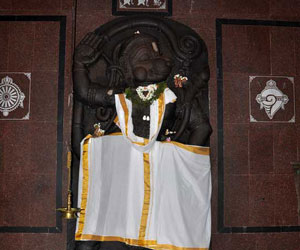 Hoysalas are known for making intricately carved stone idols used in the construction of temples. The townships they built are known for the provision of a temple at the center and providing the streets in four cardinal directions, surrounding the temple. Erecting Anjaneya statues at each of the gates at the end of each of the four streets was their hallmark. During their reign, the Hoysalas built more than 1500 temples all across their empire of which only a little over a hundred are surviving today. Hoysalas had recognised Shaivite, Vaishnavite sects, and also Jainism.
Hoysalas are known for making intricately carved stone idols used in the construction of temples. The townships they built are known for the provision of a temple at the center and providing the streets in four cardinal directions, surrounding the temple. Erecting Anjaneya statues at each of the gates at the end of each of the four streets was their hallmark. During their reign, the Hoysalas built more than 1500 temples all across their empire of which only a little over a hundred are surviving today. Hoysalas had recognised Shaivite, Vaishnavite sects, and also Jainism.
The temple ruins which were brought from Shimoga to build the Sri Shweta Varaha temple at Mysore had an idol of Sri Anjaneya also. As was the practice of the then kings, when a fort was constructed new or renovated they used to install Sri Anjaneya in all four directions. Sri Anjaneya is considered a protector and a keeper of vigil on the enemy, hence this practice. One could see this being practiced by almost all the kingdoms that derived powers to rule from Vijayanagara Samrajya. Mysore is one of them.
Sri Purnaiah was a devotee of Sri Anjaneya and helped build temples for Sri Anjaneya or helped renovate Sri Mukhya Prana temples at various places he had visited or served during his Dewanship to the Mysore Sultans and the Maharajas. He had planned to install the idol of Sri Anjaneya brought from Shimoga at the Mysore security gate known as Varaha gate [presently known as the south gate]. In all probability, this was the last temple for Sri Anjaneya that Sri Purnaiah had built.
The other Sri Hanuman temple built by him in Mysore is near Dewan Purnaiah Choultry. Kindly see our article “Dewan Purnaiah Choultry”
There is a temple for Sri Anjaneya, built by Sri. Purnaiah, at the south gate, tucked behind the kiosks where the policeman of the day frisks the visitors to the palace who enter through the south gate. Visitors will normally miss to notice this temple unless they have a keen eye for details. Devotees may note that there is no fixed time for pooja, the temple is opened by the priest in the morning for about ten minutes for pujas.
Sri Anjaneya Swamy
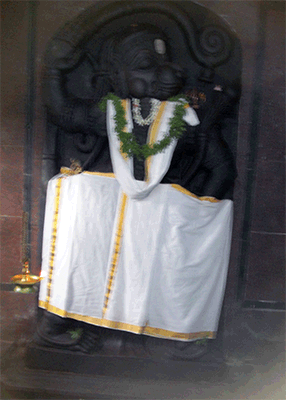 The magnificent, majestic, and gigantic idol of Sri Anjaneya. With just one look, the devotee is sure to surrender to Him. Intricately carved with all artistic skill and rich in sculptural work. The splendid craftsmanship is adorable. The excellence of the Hoysala workmanship brought in the Sri Anjaneya idol is visible throughout.
The magnificent, majestic, and gigantic idol of Sri Anjaneya. With just one look, the devotee is sure to surrender to Him. Intricately carved with all artistic skill and rich in sculptural work. The splendid craftsmanship is adorable. The excellence of the Hoysala workmanship brought in the Sri Anjaneya idol is visible throughout.
The murthi of the Lord is about twenty feet in height and east facing. Sculpted on a single stone Lord is standing on a raised platform. A path is carved in the platform so that the abishekam water does not spill all over but smoothly finds its way out. Although the idol is seen as ‘ardha shila’, the sculptor – Shilpi - had brought a three-dimensional effect so beautifully as if the idol is a full shila.
Lotus feet of Sri Anjaneya Swamy are adorned by a ‘thandai’-hollow anklet [padavalaya] just above His ankle and a plain nupur [padasaras] without any decoration also is seen. His left calf muscle is held tightly with a decorative ornament. He is wearing loincloth [kaupeenam, langoti] as a wrestler would wear. Over that, He has draped a cloth in the waist with a knot near His navel covering His thigh [urudama] and the ends of the cloth are flowing downwards. He is wearing a flat broad decorative ornament known as kanchi on His waist. Lord's strong tail [lagoolam] is decorated with rings [ankuligam-like] and rises over His head. The end of the tail is coiled and a small bell is seen tied thereto. On His broad chest, Lord is wearing yagnopaveetham and two garlands made of beads. In both wrists, He is wearing kada also known as kangan. In His upper arm, He is wearing bahuvalaya also known as Angad. His broad shoulders are decorated with bhujavalaya. His right hand is showing ‘abhaya mudra’ while in His left hand, the Lord is holding Sowgandika Pushpa.
His peacefully smiling face [prasanna vadhanam] transmits tranquility. The swollen cheek and jaw add beauty to Sri Hanuman’s pleasing look. His long hair had been braided neatly and held by kesabandha, since the braid is too long it can be seen that it has been folded. His closed eyes under a long eyebrow show that the Lord is in deep meditation. Although closed they silently convey many things to the devotees. Like Sri Dakshinamurti conveying silently explanations on Brahma Tatvam, here this Sri Rudravathara moorthi silently provides relief for all the worry that the devotee comes with. Stand in front of this Lord get the answers to your problems and go back with a light heart.
Location of the temple: "Anjaneya Swamy Temple, South Gate, Mysore Palace"
Experience
Have darshan of Sri Hanuman - the destroyer of foes and keeper of territory. Stand in front of Him for a few minutes – feel the magic wand of the Lord working on you. All the foes in your mind will vanish and you will realise your limit and territory where you can be ‘PURNA’.
SRI HANUMAN THINKS DIFFERENTLY, THINKS FAST
THINKS AHEAD AND ACTS FOR SURE
Ed [February 2024]
Updates: [Jan 2025]
* about the author Shri Kathyayini priyan
